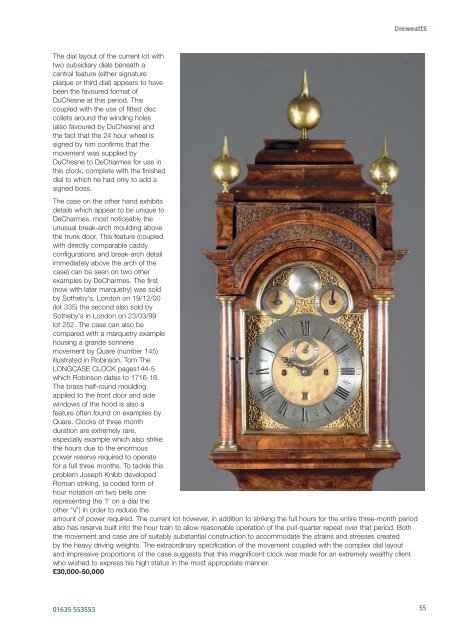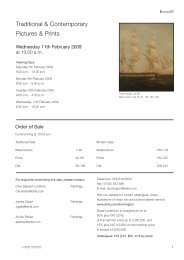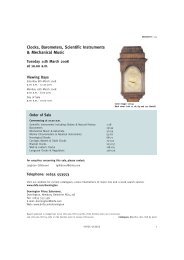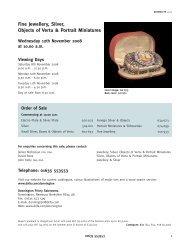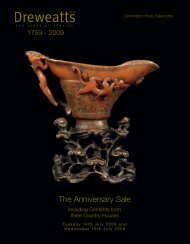Donnington Priory Salerooms
Donnington Priory Salerooms
Donnington Priory Salerooms
Create successful ePaper yourself
Turn your PDF publications into a flip-book with our unique Google optimized e-Paper software.
The dial layout of the current lot with<br />
two subsidiary dials beneath a<br />
central feature (either signature<br />
plaque or third dial) appears to have<br />
been the favoured format of<br />
DuChesne at this period. This<br />
coupled with the use of fitted disc<br />
collets around the winding holes<br />
(also favoured by DuChesne) and<br />
the fact that the 24 hour wheel is<br />
signed by him confirms that the<br />
movement was supplied by<br />
DuChesne to DeCharmes for use in<br />
this clock, complete with the finished<br />
dial to which he had only to add a<br />
signed boss.<br />
The case on the other hand exhibits<br />
details which appear to be unique to<br />
DeCharmes, most noticeably the<br />
unusual break-arch moulding above<br />
the trunk door. This feature (coupled<br />
with directly comparable caddy<br />
configurations and break-arch detail<br />
immediately above the arch of the<br />
case) can be seen on two other<br />
examples by DeCharmes. The first<br />
(now with later marquetry) was sold<br />
by Sotheby's, London on 19/12/00<br />
(lot 335) the second also sold by<br />
Sotheby's in London on 23/03/99<br />
lot 252. The case can also be<br />
compared with a marquetry example<br />
housing a grande sonnerie<br />
movement by Quare (number 145)<br />
illustrated in Robinson, Tom The<br />
LONGCASE CLOCK pages144-5<br />
which Robinson dates to 1716-18.<br />
The brass half-round moulding<br />
applied to the front door and side<br />
windows of the hood is also a<br />
feature often found on examples by<br />
Quare. Clocks of three month<br />
duration are extremely rare,<br />
especially example which also strike<br />
the hours due to the enormous<br />
power reserve required to operate<br />
for a full three months. To tackle this<br />
problem Joseph Knibb developed<br />
Roman striking, (a coded form of<br />
hour notation on two bells one<br />
representing the 'I' on a dial the<br />
other 'V') in order to reduce the<br />
amount of power required. The current lot however, in addition to striking the full hours for the entire three-month period<br />
also has reserve built into the hour train to allow reasonable operation of the pull-quarter repeat over that period. Both<br />
the movement and case are of suitably substantial construction to accommodate the strains and stresses created<br />
by the heavy driving weights. The extraordinary specification of the movement coupled with the complex dial layout<br />
and impressive proportions of the case suggests that this magnificent clock was made for an extremely wealthy client<br />
who wished to express his high status in the most appropriate manner.<br />
£30,000-50,000<br />
01635 553553<br />
55


